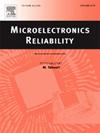利用珀尔帖效应和DBC金属轨道增强SiGe HBT集成电路的热管理
IF 1.9
4区 工程技术
Q3 ENGINEERING, ELECTRICAL & ELECTRONIC
引用次数: 0
摘要
有效的热管理仍然是SiGe异质结双极晶体管(HBT)集成电路的主要挑战,特别是在BiCMOS9MW 0.13 μm技术中。本研究提出了一种新的两阶段散热策略,将主动热电冷却与被动dbc传导相结合,这是一种以前未在此背景下探索的解决这一问题的方法。首先,利用珀尔帖效应与传统塑料包装相结合来调节电路的热性能。其次,采用直接键合铜(DBC)金属轨道在内部电路和外部散热器之间建立有效的热通道。实验结果表明,标准塑料包装本身会导致过热(Tmax = 467 K)。珀尔帖效应的加入将峰值温度显著降低至380 K,而DBC磁道的加入进一步增强了冷却,将温度降低至340 K。与仅依赖封装或外部散热器的传统冷却解决方案不同,我们的方法可以直接在芯片级实现局部可控的热量提取,确保更好的热调节和改进的电气性能。这种双重方法不仅减轻了自热,而且显著改善了直流和射频性能。其中,最大电流增益(βmax)从1913年增加到2183年,传输频率(ft)从265 GHz增加到285.6 GHz。这些发现强调了基于peltier的冷却和DBC热管理相结合在实现下一代高频应用中的有效性。本文章由计算机程序翻译,如有差异,请以英文原文为准。
Enhanced thermal management of SiGe HBT integrated circuits using the Peltier effect and DBC metal tracks
Effective thermal management remains a major challenge for SiGe heterojunction bipolar transistor (HBT) integrated circuits, particularly in BiCMOS9MW 0.13 μm technology. This study proposes a novel two-stage heat dissipation strategy that combines active thermoelectric cooling with passive DBC-based conduction an approach not previously explored in this context to address this issue. First, the Peltier effect is leveraged in combination with conventional plastic packaging to regulate circuit thermal performance. Second, Direct Bonded Copper (DBC) metal tracks are implemented to establish an efficient thermal pathway between the internal circuit and external heat sinks. Experimental results indicate that standard plastic packaging alone results in excessive heating (Tmax = 467 K). The incorporation of the Peltier effect significantly reduces the peak temperature to 380 K, while the addition of DBC tracks further enhances cooling, lowering the temperature to 340 K. Unlike traditional cooling solutions that rely solely on packaging or external heatsinks, our method enables localized, controllable heat extraction directly at the chip level, ensuring better thermal regulation and improved electrical performance. This dual approach not only mitigates self-heating but also leads to notable improvements in DC and RF performance. Specifically, the maximum current gain (βmax) increases from 1913 to 2183, and the transit frequency (ft) rises from 265 GHz to 285.6 GHz. These findings underscore the effectiveness of the combined Peltier-based cooling and DBC thermal management in enabling next-generation high-frequency applications.
求助全文
通过发布文献求助,成功后即可免费获取论文全文。
去求助
来源期刊

Microelectronics Reliability
工程技术-工程:电子与电气
CiteScore
3.30
自引率
12.50%
发文量
342
审稿时长
68 days
期刊介绍:
Microelectronics Reliability, is dedicated to disseminating the latest research results and related information on the reliability of microelectronic devices, circuits and systems, from materials, process and manufacturing, to design, testing and operation. The coverage of the journal includes the following topics: measurement, understanding and analysis; evaluation and prediction; modelling and simulation; methodologies and mitigation. Papers which combine reliability with other important areas of microelectronics engineering, such as design, fabrication, integration, testing, and field operation will also be welcome, and practical papers reporting case studies in the field and specific application domains are particularly encouraged.
Most accepted papers will be published as Research Papers, describing significant advances and completed work. Papers reviewing important developing topics of general interest may be accepted for publication as Review Papers. Urgent communications of a more preliminary nature and short reports on completed practical work of current interest may be considered for publication as Research Notes. All contributions are subject to peer review by leading experts in the field.
 求助内容:
求助内容: 应助结果提醒方式:
应助结果提醒方式:


